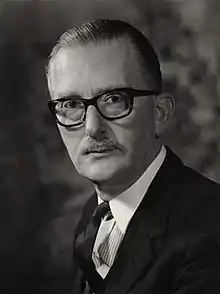Harry Legge-Bourke
Major Sir Edward Alexander Henry Legge-Bourke, KBE (16 May 1914 – 21 May 1973) was a British politician, and a Member of Parliament for Isle of Ely from 1945 until his death in 1973.[1]
Sir Harry Legge-Bourke KBE MP | |
|---|---|
 | |
| Chairman of the 1922 Committee | |
| In office 1970–1972 | |
| Preceded by | Arthur Vere-Harvey |
| Succeeded by | Edward du Cann |
| Member of Parliament for Isle of Ely | |
| In office 5 July 1945 – 21 May 1973 | |
| Preceded by | James de Rothschild |
| Succeeded by | Clement Freud |
| Personal details | |
| Born | Edward Alexander Henry Legge-Bourke 16 May 1914 Windsor, Berkshire |
| Died | 21 May 1973 (aged 59) Chelsea, London |
| Nationality | British |
| Political party | Conservative |
| Spouse(s) | Catherine Jean Grant
(m. 1938) |
| Children | William Nigel Henry Heneage Victoria Lindsay |
| Parents | Nigel Walter Legge-Bourke Victoria Alexandrina Wynn-Carington |
| Alma mater | Eton College |
Early life
Legge-Bourke was born as the only child of Lt. Nigel Walter Legge-Bourke (1889–1914), who was killed in action in World War I in October 1914, and Lady Victoria Alexandrina Wynn-Carington (1892–1966). Through his paternal grandfather, soldier and courtier Henry Legge, he was a great-grandson of the 5th Earl of Dartmouth. His maternal grandfather was the Marquess of Lincolnshire, and his maternal grandmother, the Hon. Cecilia Margaret née Harbord, was the daughter of the 5th Baron Suffield.
He served alongside Jock Colville (his half–second cousin[2]) as a Page of Honour from 1926.[3] Educated at Eton College and the Royal Military College, Sandhurst, Legge-Bourke was commissioned into the Royal Horse Guards in 1934. He served there throughout the World War II, rising to the rank of major. In 1941, he was liaison officer, GHQ, British Forces in Greece, and served with the 7th Armoured Division at El Alamein.[1]
Politics
Legge-Bourke was elected Member of Parliament for Isle of Ely in 1945 as a member of the Conservative Party.[4] His gain from the Liberal James de Rothschild was one of the few Conservative gains of the election. Legge-Bourke was prominent as a chairman of the 1922 Committee of Conservative backbenchers. In 1960 he was invested as a KBE. As an East Anglian representative, he was particularly interested in land drainage and was vice-President of the Association of Drainage Authorities.[1] A popular local MP, he did instruct Prime Minister Clement Attlee to "Change the bloody record" as he threw a coin at him – an incident which had him briefly debarred from the Commons.[5]
Family
Legge-Bourke married Catherine Jean Grant (1917–2007), daughter of Colonel Sir Arthur Grant of Monymusk, 10th Bt, and Evelyn Alice Lindsay Wood. They had three children:
- William Nigel Henry Legge-Bourke (1939–2009); married the Hon. Elizabeth Shân Josephine Bailey, daughter of the 3rd Baron Glanusk, and had issue.
- Heneage Legge-Bourke (born 1948); married Maria Clara de Sá-Carneiro, and had issue (including Eleanor Legge-Bourke).
- Victoria Lindsay Legge-Bourke (born 1950).
He inherited a fraction of the Lord Great Chamberlainship of England, succeeded by his son, William. His daughter-in-law, the Hon. Shân Legge-Bourke, Lord Lieutenant of Powys, was made a lady-in-waiting to Elizabeth II. His granddaughter, Alexandra "Tiggy" Legge-Bourke (now Pettifer), was nanny to Princes William and Harry. Another granddaughter, Eleanor Legge-Bourke, is a television personality in France.
Legge-Bourke died in 1973, aged 59, whilst still a Member of Parliament. The by-election to replace him was won by Liberal Clement Freud. Legge-Bourke and his wife were cremated and their ashes buried in Ely Cathedral.
References
- Barnes, John. "Sir Harry Legge-Bourke KBE (1914-1973)". Retrieved 23 April 2017.
- Both were great-grandsons of Robert Carrington, 2nd Baron Carrington.
- Footprints in Time. John Colville. 1976. Chapter 3, The Loss of a Shirt.
- Craig, F. W. S., ed. (1969). British parliamentary election results 1918-1949. Glasgow: Political Reference Publications. p. 378. ISBN 0-900178-01-9.
- Freud, Clement (13 April 1997). "MY WEEK Clement Freud". The Independent. Retrieved 23 April 2017.
External links
- Hansard 1803–2005: contributions in Parliament by Sir Harry Legge-Bourke
| Parliament of the United Kingdom | ||
|---|---|---|
| Preceded by James de Rothschild |
Member of Parliament for Isle of Ely 1945–1973 |
Succeeded by Clement Freud |
| Political offices | ||
| Preceded by Sir Arthur Vere Harvey |
Chairman of the 1922 Committee 1970–1972 |
Succeeded by Sir Edward du Cann |